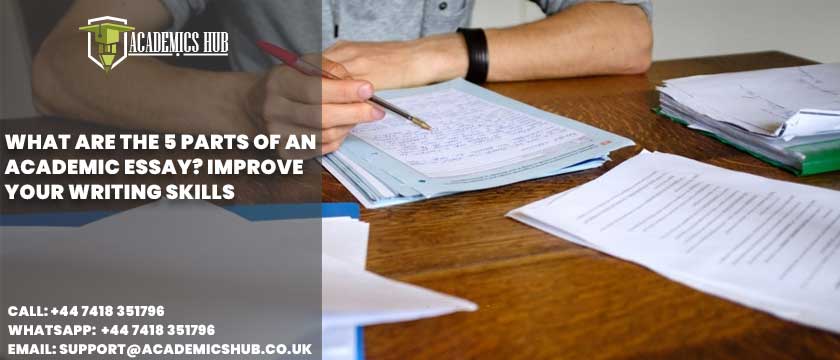Academic essay writing is a piece of writing meant to persuade someone of something or merely to inform the reader on a topic. The essay must include numerous crucial components for the reader to be convinced or fully informed, and it must flow logically. The introduction, body, and conclusion are the three main components of an essay. Five paragraphs in a standard short essay can supply the reader with enough information in a short amount of time. Academic essay writing is a part of a student’s academic life. They have to submit their academic tasks during their educational career. Without the submission of their assignments, students can’t score high grades in exams.
But, students, due to many reasons, struggle with their homework. They wonder and ask: who can do my homework? Can I get assistance with an academic essay? Or, Can I seek help from a professional essay writer? Well! You can ask for help from online academic writing service providers. In this blog, I have discussed the five parts of an academic essay and how you can improve your essay writing skills.
Parts of Academic Essay

Essay writing is a type of academic assignment that assists students to improve their writing, critical thinking, introspection, and analytical skills. Your professor may provide you with different types of essays such as narrative, expository, persuasive, and comparative. Teachers provide students with details such as which essay to write and what topic to write it on. When writing a 5-paragraph essay, students must ensure that they capture content in five parts that address different but related topics.
Introduction
In academic writing, it is standard for students to begin each work with an introduction. The introduction, which follows a five-part format, sets the tone for the author’s claims in the main text. Students must ensure three things in this section: that they have the readers’ attention, that they have contextualized their message, and that the text’s objective is apparent. In short, the introduction consists of a hook, background information about the issue, and a thesis statement.
Hook: Students should begin the opening section with a hook to increase readers’ interest. This should ideally be a strong, eye-catching remark that attracts the reader’s attention and entices them to continue reading the essay. If a researcher knows how to create a hook, they know who they’re writing for. Furthermore, the purpose of the hook is to ensure that the audience is fully engaged in the essay right from start.
Background Information: The greatest technique to make the audience interested in what the writers say in their work is to provide background information on the topic. To put it another way, commencing this section of a five-part essay with assertions and arguments without providing readers with material that familiarises them with issues important to the topic is like leading blind followers. Background information informs the readers about the topic’s context.
Thesis Statement: It is the declaration that authors make at the end of their essay’s introduction section. Essentially, the purpose of this remark is to demonstrate the writer’s major point throughout the text. Furthermore, all of the body paragraphs should provide content that supports this assertion.
Arguments in Academic Essay

The body is the second part that makes up an essay. Students go into the topic in depth by analyzing evidence that supports their position. Writers use the thesis statement as a guide to offer readers appropriate details about the topic. The first part of the body of an essay emphasizes the writer’s arguments.
Writer’s Claims: The fundamental content of an argumentative essay’s body paragraphs is claimed. Students make claims in support of the thesis statement in the first part of this section. These claims, in general, differ from the writer’s personal opinion since they are supported by evidence from scholarly texts. Furthermore, authors can make as many assertions as they choose. However, there should not be too many statements throughout the article if the author’s voice is to be heard. Then, for each assertion made by students, there must be evidence to back it up as well as the author’s perspective.
Evidence: In an academic essay, facts and figures discovered by students while researching the topic are known as evidence. Authors should rely on scholarly sources to find evidence to support their statements, according to academic writing guidelines. The most popular criteria for recognizing scholarly sources are:
- Sources must have an author with prominent academic credentials
- Sources must be published, such as journal articles and books
- And, sources must be written in a formal language without jargon or slang.
Counter Argument
Counter arguments are addressed in the third part of an essay, which is the second portion of the main body. In an ideal world, a writer would not explain arguments in support of a topic without acknowledging opposing viewpoints. The counter-argument section is where the authors mention critical and scholarly discussions that refute the thesis statement’s claim. Writers should back up these counter-arguments with information from academic sources to ensure that the overall document is scholarly.
Rebuttal
After mentioning counter-arguments to the thesis’ major argument, students should reject these statements. The rebuttal is the fourth portion of the paragraph of the academic essay, which is also the third half of the main text. In this situation, writers confront opposing arguments to persuade readers of the truth of the thesis statement’s proposition. Then, while writing refutations, the ideal strategy is to point out any significant faults in the counter-argument. In short, the purpose of this section is to persuade readers that, despite opposing evidence, the writer’s thesis is sound.
Essentials of compelling paragraphs: Students must ensure that what they write in these sections is compelling while organizing three body sections from 5 parts of an academic essay. A topic phrase should be used to begin each of the three body paragraphs of a five-paragraph essay — the argument, counter-argument, and rebuttal sections. Scholars who understand how to create a topic sentence, for example, recognize that it establishes the writer’s attention in that paragraph. All topic phrases, however, should be related to the thesis statement to have a correct logical flow.
As a result, each paragraph should end with a concluding sentence. This statement, in turn, connects the topic phrase to the thesis statement and establishes a link to the next section. Furthermore, evidence, analysis, and interpretation make up the substance between the theme and the ending words.
Conclusion
The conclusion is the final part of an academic essay. It is, in essence, a place where authors may unwind. Basically, the risks of readers losing interest in the author’s purpose are always high near the end of an essay. As a result, in the conclusion section, authors should restate the thesis statement to remind the audience of the paper’s original purpose. A description of the claims, including the writer’s arguments, counter-arguments, and refutations, should follow. Furthermore, despite conflicting evidence, researchers should be clear that their arguments are valid. The final remark, on the other hand, should represent the writer’s final thought.
How to Improve Academic Essay Writing Skills?

Many people undervalue the significance of excellent writing skills. Continue reading to find out how you can help people improve their written communication abilities, which is perhaps one of the most important skills to have. Academic writing is entirely based on statistics and facts. Creating an academic paper is not a one-day task. A good academic paper contains diligent research through credible scholarly sources, data collation, content assimilation, and final paper drafting. All of these tasks necessitate effective management abilities.
- You can improve your academic writing skills by planning out your day and dedicating some time to writing activities.
- Reading well-written and formatted work can help you gain a better understanding of scientific writing style.
- Most importantly, reading books and papers on similar or closely related topics will assist you in discovering your analytical abilities.
- Reading the works of different authors also helps you learn different aspects of writing to communicate with a larger audience.
- Don’t use unnecessary vocabulary in academic essay writing.
- It is critical to understand the words you use and how they relate to the context. Avoid using jargon in your academic essay so that it is accessible and understandable to all readers.
- Improve your grammar by focusing on the fundamentals.
- Read aloud because errors that pass through the eyes may not pass through the ears.
- If you are aware of the most common errors, make a list of them and search for each type of error separately.
Conclusion
Academic essay writing is a crucial part of a student’s academic life. An academic essay requires research, time, effort, and effective writing skills. Students often find it tedious to compose compelling essays. Academic essay writing consists of five parts. Everybody can write an effective paper after following all the above-mentioned parts of essay writing. Also, in this blog, I have discussed a few points of how you can improve your writing skills. If you still don’t want to craft your paper, get online assistance from essay writers.
